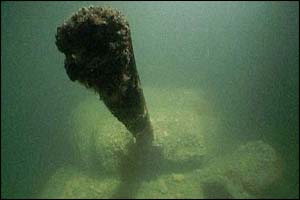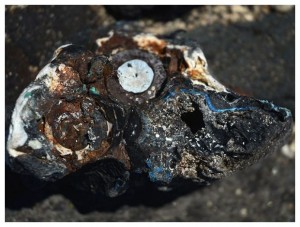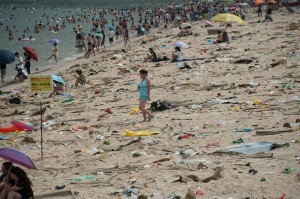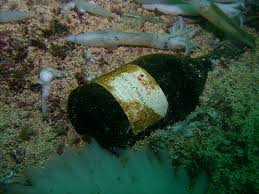June 6, 2014 – It is the 70th anniversary of D-Day, the Western Allied invasion of the Normandy coast of France. Today, submerged beyond the beaches lie the relics of a past war. But they will eventually break down through oxidation to become no more than a memory.
In the Anthropocene, however, we will have created a more permanent record of our presence, a new type of rock (seen below) which geologists call plastiglomerate.
As you can imagine by the name, plastic is a key ingredient in these new rocks. How they form can be seen in the evidence any given day just by walking on an ocean beach. The very unflattering picture below was taken of Shenzhen beach in China. The washed up plastic debris you see here, if not removed, will eventually begin a slow process of disintegration turning into finer and finer particles. These will then adhere to the sand, small rocks, and even washed up organics to eventually form a conglomerate that solidifies over time to become plastiglomerate.
In a paper presented to The Geological Society of America, released today, and entitled “An anthropogenic marker horizon in the future rock record,” American and Canadian researchers describe the process of agglutination of natural sediments to plastic which then gets buried and preserved. Some of this agglutination occurs from plastics that melt in beach campfires. Other agglutination comes from chemical reaction and the heat of the Sun.
In sampling beaches the scientists found loose resin pellets, polystyrene fragments and other plastics within the upper 5 centimeters (approximately 2 inches). And as they dug down less and less loose micro-plastic was in evidence. At a depth of one meter (+39 inches) none could be found. Instead the plastic had become bound with other material. This is the beginning of the formation of plastiglomerate, humanities contribution to the geological record.
The scientists looked at the accumulation of debris in ocean sea beds. In Monterey Bay, California, they found that 33% of the ocean floor debris was plastic. A sample of the ocean floor can be seen in the image below. Similar findings became evident in many other areas sampled. At some point sedimentation will bury this debris which will also lead to the creation of plastiglomerate over time.
As you can imagine the process of agglutination is by no means immediate. The researchers estimate that the plastic waste we produce and discard today may persist in the environment for hundreds of thousands of years.
The term Anthropocene has been mentioned before by me in previous postings. It is recently defined separating our technological civilization from the Holocene, the age we most often associate with the geological record of the present day. Plastic is by no means the only evidence we are depositing in the geologic record. Human activity in the form of the burning of leaded gasoline has found its way into soil signatures that will also be preserved in rock at some future time. Today these lead laced sediments can be found in bogs, swamps and ponds across the planet.
But plastic will surely define our age in the geological record. Where lead could have natural origins, plastic cannot. And in our present world it is ubiquitous, distributed right across the planet from the depths of the oceans to the heights of Mount Everest.
When the soldiers of D-Day assaulted the beaches of Normandy they left relics of the battle. We revere these testaments to the bravery of humans. But what of the plastic waste that we humans are leaving as our legacy here in the post-World War world? This is a different type of testament and not one to revere.












